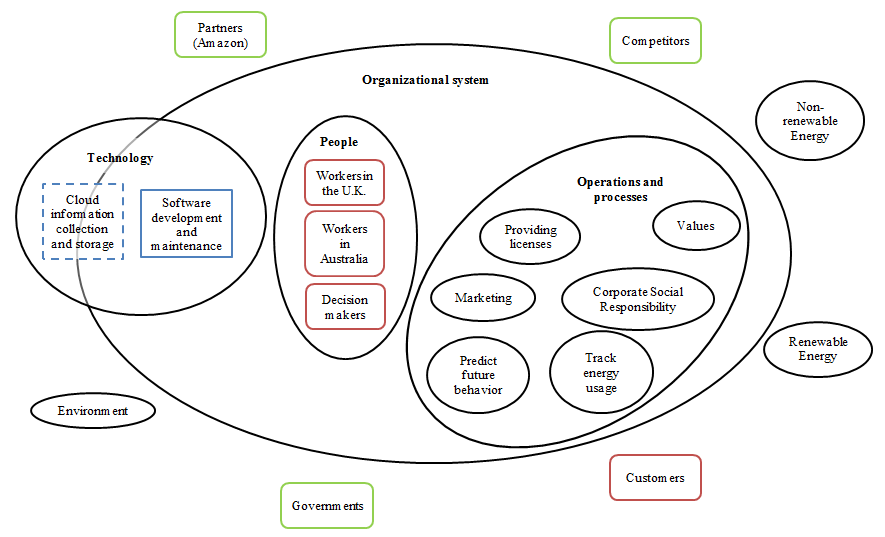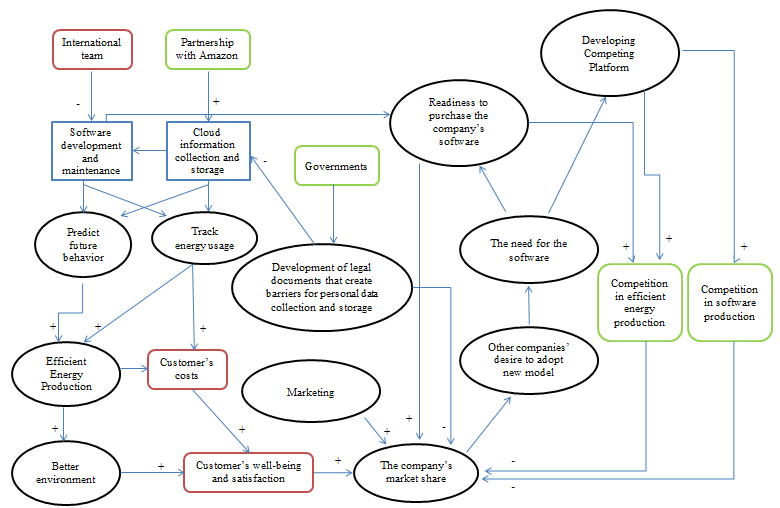Mapping Sociotechnical System

Note: Red boxes include people inside and outside of the organizational system, green boxes – related organizations, and blue boxes – technology.
The systems map presented in Figure 1 shows the crucial elements within the company and the external elements that may affect its business processes. It is organized in such a manner to demonstrate that Octopus Energy, although an independent entity, should not be viewed separately from the environmental forces. The latter were excluded from the main circle because they are beyond the organization’s direct control. Therefore, the main insight that can be found in the systems map is that the company actively interacts and depends on different elements outside its ‘borders’.

Note: Red boxes include people inside and outside of the organizational system, green boxes – related organizations, and blue boxes – technology.
Systems diagram compared to the systems map provides insights concerning the interactions between various stakeholders, technology, and processes. However, it does not include the links that exist between external agents that do not directly affect the company’s business. As such, Figure 2 shows that there is one weakness and one threat that Octopus Energy should address, namely a divided team of software developers and the attempts to copy the Kraken by other businesses accordingly.
ETHICS Framework
ETHICS theory seeks to provide a framework to create working systems that combine technical efficiency with user-friendliness. In this regard, the IT system described in the case study can be analyzed using the steps proposed by Mumford (Sadath & Gill, 2017). Firstly, it is necessary to determine the reasons for developing the new technology, which in the case of Octopus Energy are a more efficient provision of energy and reduction of customer costs and environmental impact. Secondly, the identification of existing system boundaries and processes should be described using the system maps and diagrams. Next, the problems related to efficiency and employee or customer satisfaction should be identified. In this regard, the previous analysis indicated that dividing the operations between workers in Australia and the U.K. serves as a barrier for higher efficiency. Then, the managers should devise a system that would not have the revealed issues. Therefore, decision-makers in Octopus Energy should consider creating a single software development team that would work in one location. Finally, after implementing the changes, the results should be critically evaluated.
Issues of Power
The success of any company’s operations is significantly determined by its leader’s ability to align the various interests of its stakeholders. In the case of Octopus Energy, the parties that are interested and affected by the business include the general population, partners, governments, employees, and the company managers. However, the power distribution between various actors is not distributed equally, which may potentially lead to issues of power between them. For instance, Octopus Energy stores its information in the Amazon Web Services cloud. Therefore, such a dependence on solely one business partner deprives the company of flexibility and choice, thus granting Amazon increased bargaining power.
Additionally, as was mentioned by Eddison, the governments in different countries may have or introduce legal documents that restrict or forbid personalized data collection through the internet. In this regard, the company managers have little power to affect the government officials’ actions. However, the pursuit of the abovementioned laws may be explained by the fact that by having access to personalized data, the companies may use this information illegally. Thus, it is seen that there may be potential power issues in Octopus Energy’s relations with its customers.
Reference
Sadath, L., & Gill, S. (2017). ETHICS and SSM—A critical human element evaluation in software engineering using the NIMSAD framework. In Khatri S. K. et al. (Eds.), 2017 International Conference on Infocom Technologies and Unmanned Systems (Trends and Future Directions)(ICTUS) (pp. 370-375). IEEE.